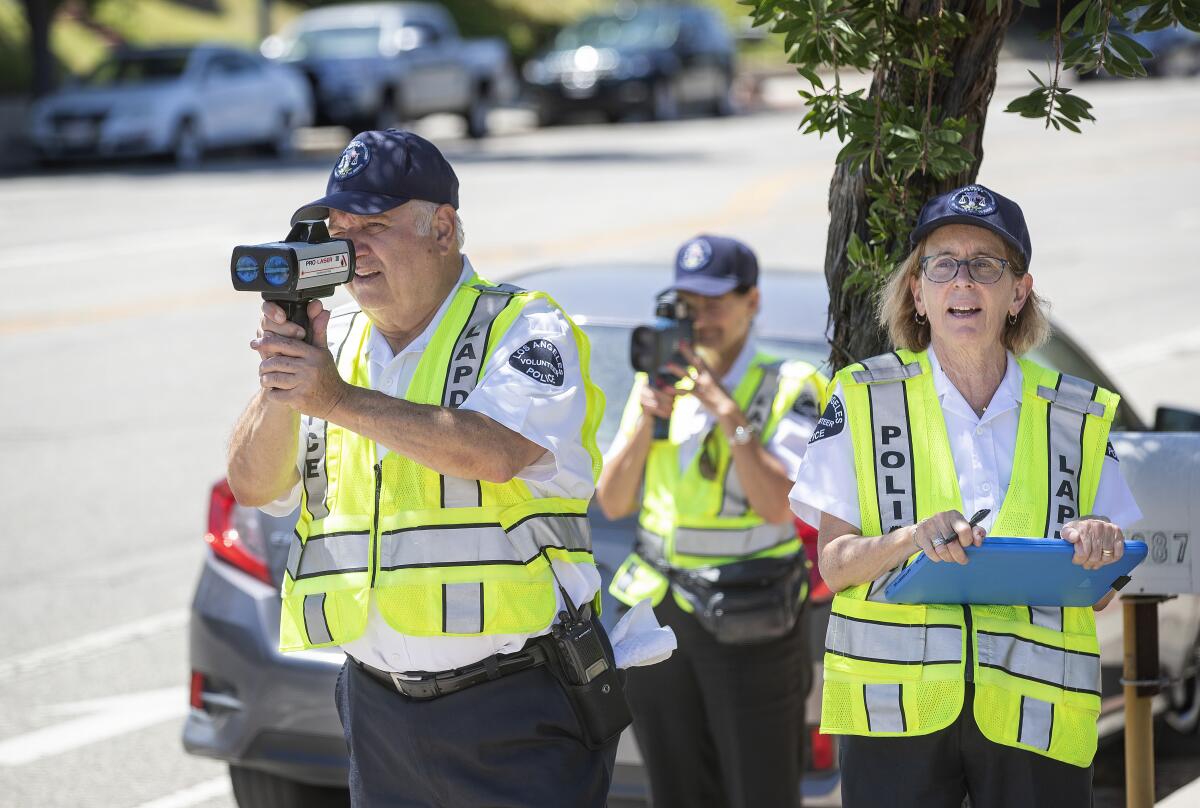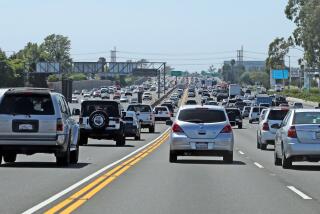Editorial: Speed kills. It’s time for California to slow down cars

- Share via
The Los Angeles City Council was recently forced to raise speed limits on sections of Olympic and Overland boulevards in West L.A. — where a woman was killed this year by a recklessly speeding driver.
Why? Because an outdated and absurd law essentially requires cities to set street limits based on how fast people are already driving on a stretch of road — not whether that speed is safe.
This law is based on a flawed methodology, according to a report released last year. It relies on the overly optimistic assumption that most drivers will drive at a safe and reasonable speed, and that it’s safer to set speed limits that reflect the “natural” flow of traffic.
But as anyone who’s observed public streets during the pandemic can attest to, drivers do not “naturally” drive at a safe and reasonable speed. While people drove 13% fewer miles in 2020, the mileage death rate went up 24%, the highest estimated year-over-year increase in 96 years, according to the National Safety Council.
In short, more pedestrians and cyclists are getting killed in crashes involving motor vehicles, and existing speed limit rules are doing nothing to stop that trend.
Research suggests that drivers frequently underestimate how fast they’re driving by 10% to 30%. The National Transportation Safety Board has said there is no convincing evidence that pegging speed limits to traffic flow results in safer streets.
For the last several years, Assemblywoman Laura Friedman (D-Glendale) has been trying to convince her fellow lawmakers to revise the state’s woefully out-of-date speed limit laws. But in California, too many leaders (and their constituents) look at the world through a windshield, and so efforts to make streets safer and slower have faced uphill battles.
Friedman is back this year with Assembly Bill 43, an entirely reasonable bill that would let cities lower speed limits by 5 miles per hour on streets with high rates of injuries, or routes well used by pedestrians and bicyclists. In essence, the bill would let cities fulfill their basic responsibility to make the streets safer for everyone.
At issue is the so-called 85th percentile rule. In order for police to use radar guns or other electronic devices to help enforce speed limits on a particular street, cities have to conduct regular surveys of traffic there. The limit must then be set at a speed exceeded by only 15% of the vehicles surveyed, rounded to the nearest 5 mph. The law was adopted more than 60 years ago to prevent cities from setting so-called speed traps — arbitrarily low speed limits aimed at sticking drivers with pricey tickets.
The mandate means that if cities want to enforce the speed limit on a street where drivers routinely put the pedal to the metal, they often have to raise it to a level where most of that behavior would be legal. The result is speed creep. Higher speed limits encourage motorists to drive faster, which in turn prompts higher speed limits. That’s why L.A. has had to raise speed limits, sometimes repeatedly, despite community concerns about dangerous driving.
Critics of AB 43 argue that speed limits have little effect on speeding. Rather, drivers’ speed matches the design of the road. That’s mostly true, and it’s why we wholeheartedly support redesigning streets to slow down traffic and make them safer for pedestrians and bicyclists. But roadway redesigns take study, money and public buy-in. Communities could be left waiting years for safer street design, while the death toll from speeding continues to rise.
Lowering the speed limit can help save lives now. Speed limits do have some effect on driver behavior; the threat of a speeding ticket can be a powerful tool to slow down drivers. And even small reductions in speed can mean the difference between life and death. A pedestrian or cyclist hit by a vehicle traveling 35 mph has a 68% chance of survival. A person hit by vehicle traveling at 40 mph has only a 35% chance of survival.
Skeptics of the bill suggest that lowering speed limits could disproportionately affect low-income communities of color, particularly if police ramp up enforcement. There’s a long history of discriminatory traffic enforcement, with a disproportionate effect on Black and Latino drivers. And the steep cost of a speeding ticket — more than $200 for going up to 15 mph over the speed limit — can be devastating for a person living paycheck to paycheck.
Yet it’s clear that speeding also disproportionately affects low-income communities of color, where there are greater numbers of pedestrians and bicyclists because residents cannot afford the cost of owning a car. In Los Angeles, a majority of the high-injury streets are in those very communities.
That’s one reason the city’s Department of Transportation supported Assembly Bill 550 to test automated speed enforcement in L.A. and several other cities. The bill by Assemblyman David Chiu (D-San Francisco) was an attempt to let cities use speed cameras and lower-cost infractions as another tool to combat dangerous driving, rather than relying on police and pricey tickets. But the bill was abruptly shelved by Assembly leaders in the spring, and it’s unclear whether Chiu will try again.
California can’t keep clinging to outdated laws and policies that favor motorists. Speed kills. It’s time for state leaders to slow down and save lives.
More to Read
A cure for the common opinion
Get thought-provoking perspectives with our weekly newsletter.
You may occasionally receive promotional content from the Los Angeles Times.










